MBA Report: Organizational Restructuring of Royal Dutch Shell (Shell)
VerifiedAdded on 2023/05/30
|33
|7259
|158
Report
AI Summary
This report provides a detailed analysis of the organizational restructuring of Royal Dutch Shell (Shell). It begins by evaluating Shell's organizational structure, leadership approaches, and dominant organizational behavior theory, highlighting its matrix structure and bureaucratic tendencies. The report then critically analyzes the changes within the organization, including the shift from a geographically-based to a business sector-based structure, and assesses the HR strategies that supported this transition. A significant portion of the report is dedicated to a 12-month personal development plan, explaining how personal development objectives influence employability within the workplace and wider society. The report also demonstrates a critical awareness of the preferred method of learning and its contribution to interacting with others. The restructuring aimed to enhance control, reduce costs, and improve shareholder returns, ultimately leading to a more efficient and focused organization. The report also touches upon the evolution of Shell's leadership principles, emphasizing authenticity, collaboration, growth, and performance.
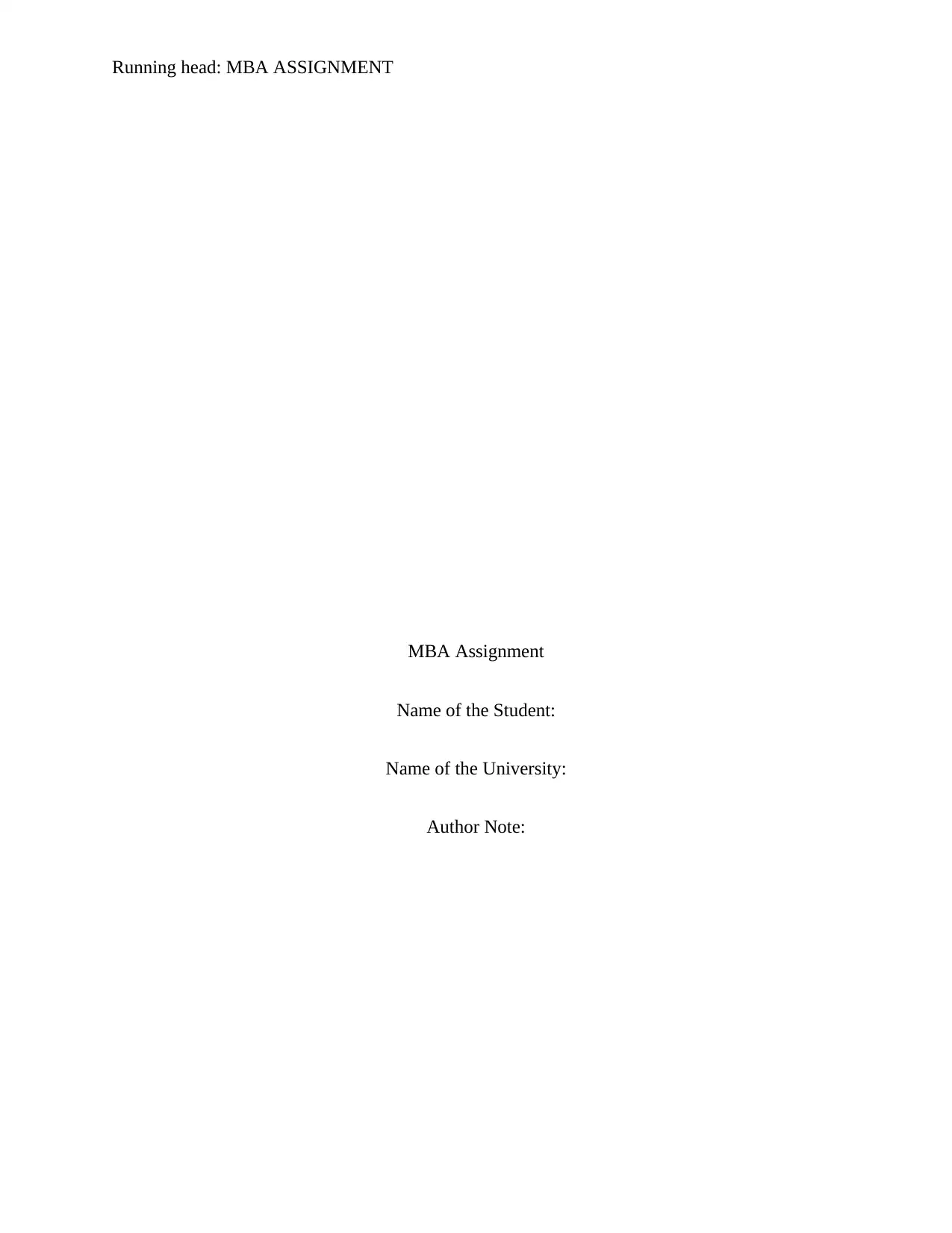
Running head: MBA ASSIGNMENT
MBA Assignment
Name of the Student:
Name of the University:
Author Note:
MBA Assignment
Name of the Student:
Name of the University:
Author Note:
Paraphrase This Document
Need a fresh take? Get an instant paraphrase of this document with our AI Paraphraser
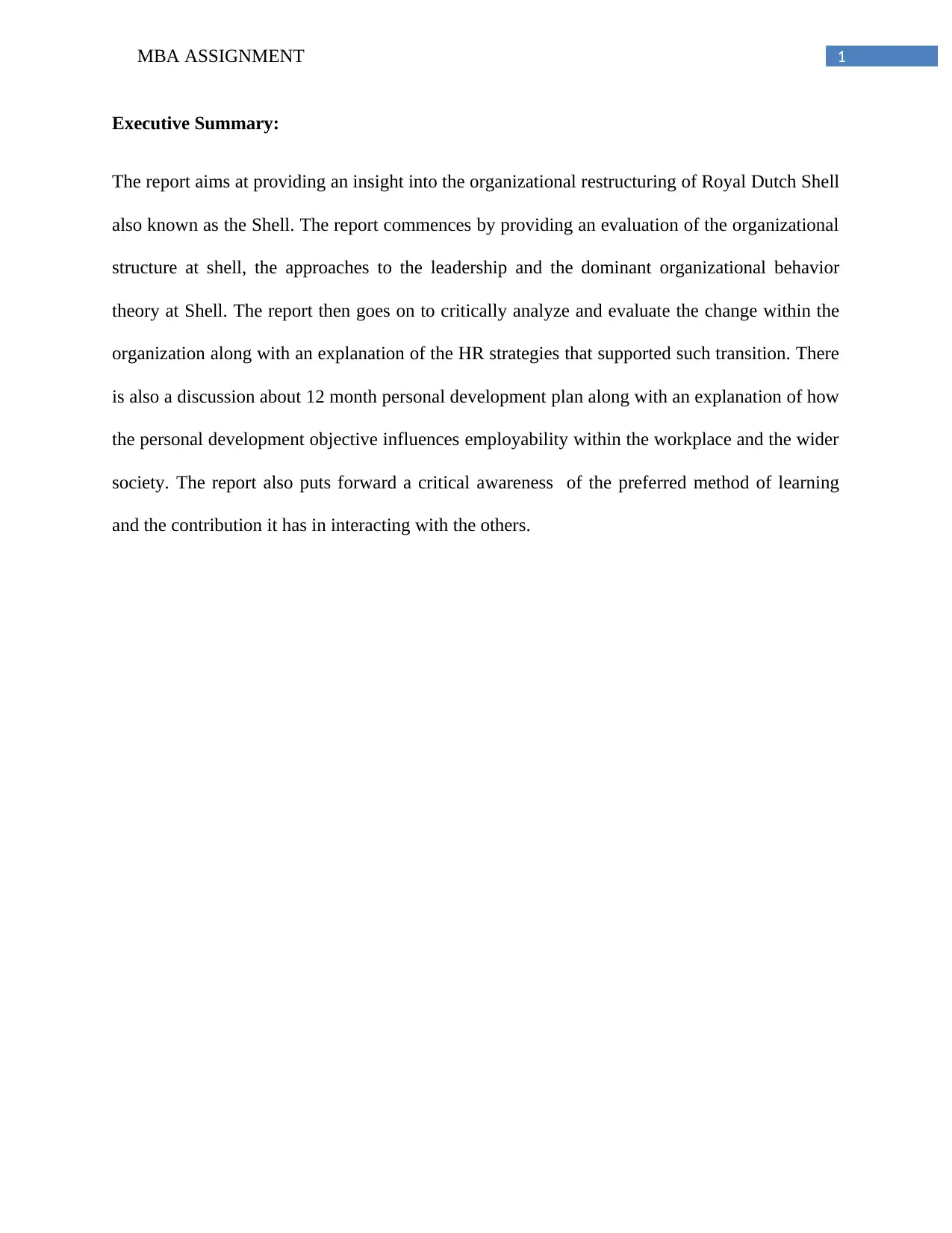
1MBA ASSIGNMENT
Executive Summary:
The report aims at providing an insight into the organizational restructuring of Royal Dutch Shell
also known as the Shell. The report commences by providing an evaluation of the organizational
structure at shell, the approaches to the leadership and the dominant organizational behavior
theory at Shell. The report then goes on to critically analyze and evaluate the change within the
organization along with an explanation of the HR strategies that supported such transition. There
is also a discussion about 12 month personal development plan along with an explanation of how
the personal development objective influences employability within the workplace and the wider
society. The report also puts forward a critical awareness of the preferred method of learning
and the contribution it has in interacting with the others.
Executive Summary:
The report aims at providing an insight into the organizational restructuring of Royal Dutch Shell
also known as the Shell. The report commences by providing an evaluation of the organizational
structure at shell, the approaches to the leadership and the dominant organizational behavior
theory at Shell. The report then goes on to critically analyze and evaluate the change within the
organization along with an explanation of the HR strategies that supported such transition. There
is also a discussion about 12 month personal development plan along with an explanation of how
the personal development objective influences employability within the workplace and the wider
society. The report also puts forward a critical awareness of the preferred method of learning
and the contribution it has in interacting with the others.
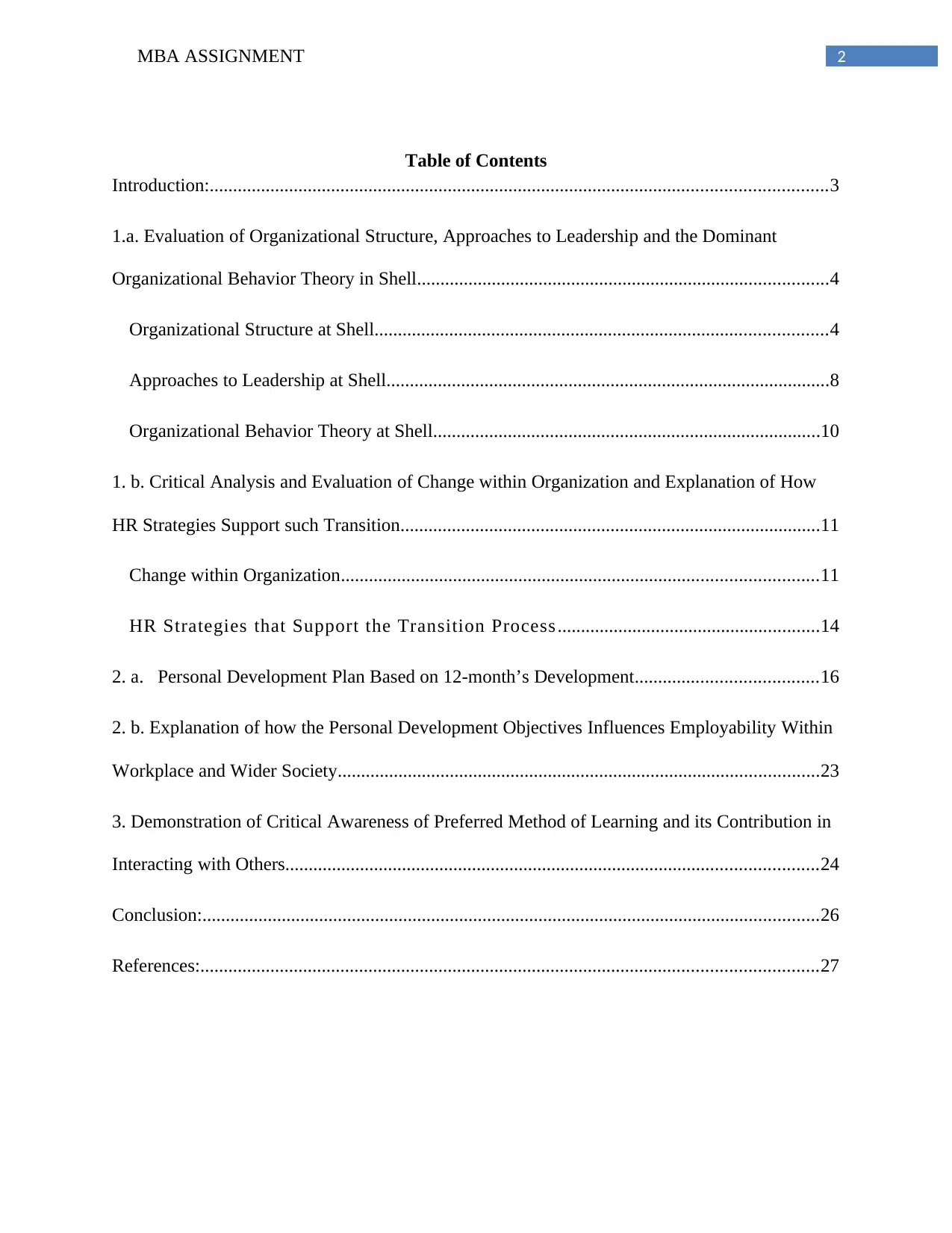
2MBA ASSIGNMENT
Table of Contents
Introduction:....................................................................................................................................3
1.a. Evaluation of Organizational Structure, Approaches to Leadership and the Dominant
Organizational Behavior Theory in Shell........................................................................................4
Organizational Structure at Shell.................................................................................................4
Approaches to Leadership at Shell...............................................................................................8
Organizational Behavior Theory at Shell...................................................................................10
1. b. Critical Analysis and Evaluation of Change within Organization and Explanation of How
HR Strategies Support such Transition..........................................................................................11
Change within Organization......................................................................................................11
HR Strategies that Support the Transition Process ........................................................14
2. a. Personal Development Plan Based on 12-month’s Development.......................................16
2. b. Explanation of how the Personal Development Objectives Influences Employability Within
Workplace and Wider Society.......................................................................................................23
3. Demonstration of Critical Awareness of Preferred Method of Learning and its Contribution in
Interacting with Others..................................................................................................................24
Conclusion:....................................................................................................................................26
References:....................................................................................................................................27
Table of Contents
Introduction:....................................................................................................................................3
1.a. Evaluation of Organizational Structure, Approaches to Leadership and the Dominant
Organizational Behavior Theory in Shell........................................................................................4
Organizational Structure at Shell.................................................................................................4
Approaches to Leadership at Shell...............................................................................................8
Organizational Behavior Theory at Shell...................................................................................10
1. b. Critical Analysis and Evaluation of Change within Organization and Explanation of How
HR Strategies Support such Transition..........................................................................................11
Change within Organization......................................................................................................11
HR Strategies that Support the Transition Process ........................................................14
2. a. Personal Development Plan Based on 12-month’s Development.......................................16
2. b. Explanation of how the Personal Development Objectives Influences Employability Within
Workplace and Wider Society.......................................................................................................23
3. Demonstration of Critical Awareness of Preferred Method of Learning and its Contribution in
Interacting with Others..................................................................................................................24
Conclusion:....................................................................................................................................26
References:....................................................................................................................................27
⊘ This is a preview!⊘
Do you want full access?
Subscribe today to unlock all pages.

Trusted by 1+ million students worldwide
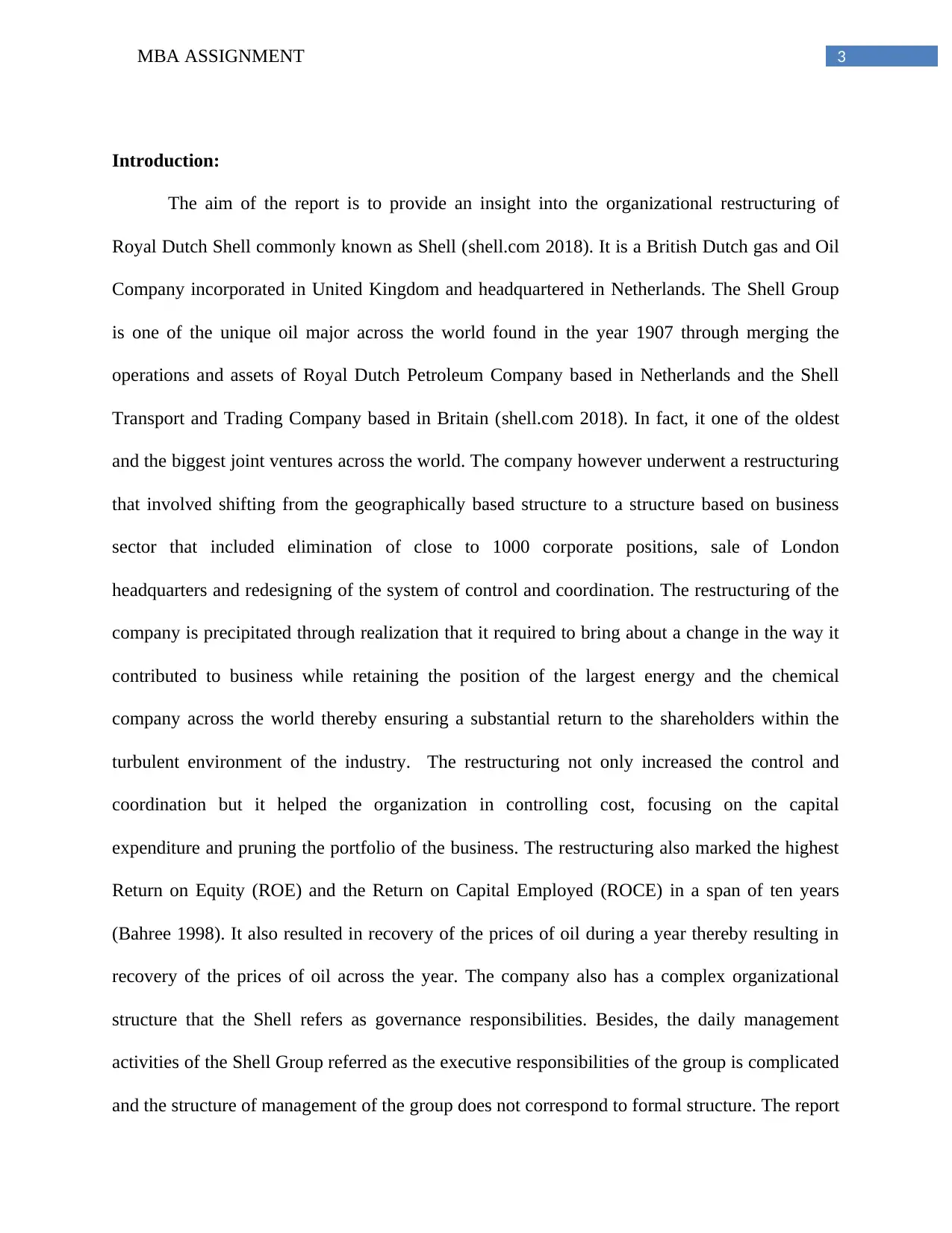
3MBA ASSIGNMENT
Introduction:
The aim of the report is to provide an insight into the organizational restructuring of
Royal Dutch Shell commonly known as Shell (shell.com 2018). It is a British Dutch gas and Oil
Company incorporated in United Kingdom and headquartered in Netherlands. The Shell Group
is one of the unique oil major across the world found in the year 1907 through merging the
operations and assets of Royal Dutch Petroleum Company based in Netherlands and the Shell
Transport and Trading Company based in Britain (shell.com 2018). In fact, it one of the oldest
and the biggest joint ventures across the world. The company however underwent a restructuring
that involved shifting from the geographically based structure to a structure based on business
sector that included elimination of close to 1000 corporate positions, sale of London
headquarters and redesigning of the system of control and coordination. The restructuring of the
company is precipitated through realization that it required to bring about a change in the way it
contributed to business while retaining the position of the largest energy and the chemical
company across the world thereby ensuring a substantial return to the shareholders within the
turbulent environment of the industry. The restructuring not only increased the control and
coordination but it helped the organization in controlling cost, focusing on the capital
expenditure and pruning the portfolio of the business. The restructuring also marked the highest
Return on Equity (ROE) and the Return on Capital Employed (ROCE) in a span of ten years
(Bahree 1998). It also resulted in recovery of the prices of oil during a year thereby resulting in
recovery of the prices of oil across the year. The company also has a complex organizational
structure that the Shell refers as governance responsibilities. Besides, the daily management
activities of the Shell Group referred as the executive responsibilities of the group is complicated
and the structure of management of the group does not correspond to formal structure. The report
Introduction:
The aim of the report is to provide an insight into the organizational restructuring of
Royal Dutch Shell commonly known as Shell (shell.com 2018). It is a British Dutch gas and Oil
Company incorporated in United Kingdom and headquartered in Netherlands. The Shell Group
is one of the unique oil major across the world found in the year 1907 through merging the
operations and assets of Royal Dutch Petroleum Company based in Netherlands and the Shell
Transport and Trading Company based in Britain (shell.com 2018). In fact, it one of the oldest
and the biggest joint ventures across the world. The company however underwent a restructuring
that involved shifting from the geographically based structure to a structure based on business
sector that included elimination of close to 1000 corporate positions, sale of London
headquarters and redesigning of the system of control and coordination. The restructuring of the
company is precipitated through realization that it required to bring about a change in the way it
contributed to business while retaining the position of the largest energy and the chemical
company across the world thereby ensuring a substantial return to the shareholders within the
turbulent environment of the industry. The restructuring not only increased the control and
coordination but it helped the organization in controlling cost, focusing on the capital
expenditure and pruning the portfolio of the business. The restructuring also marked the highest
Return on Equity (ROE) and the Return on Capital Employed (ROCE) in a span of ten years
(Bahree 1998). It also resulted in recovery of the prices of oil during a year thereby resulting in
recovery of the prices of oil across the year. The company also has a complex organizational
structure that the Shell refers as governance responsibilities. Besides, the daily management
activities of the Shell Group referred as the executive responsibilities of the group is complicated
and the structure of management of the group does not correspond to formal structure. The report
Paraphrase This Document
Need a fresh take? Get an instant paraphrase of this document with our AI Paraphraser
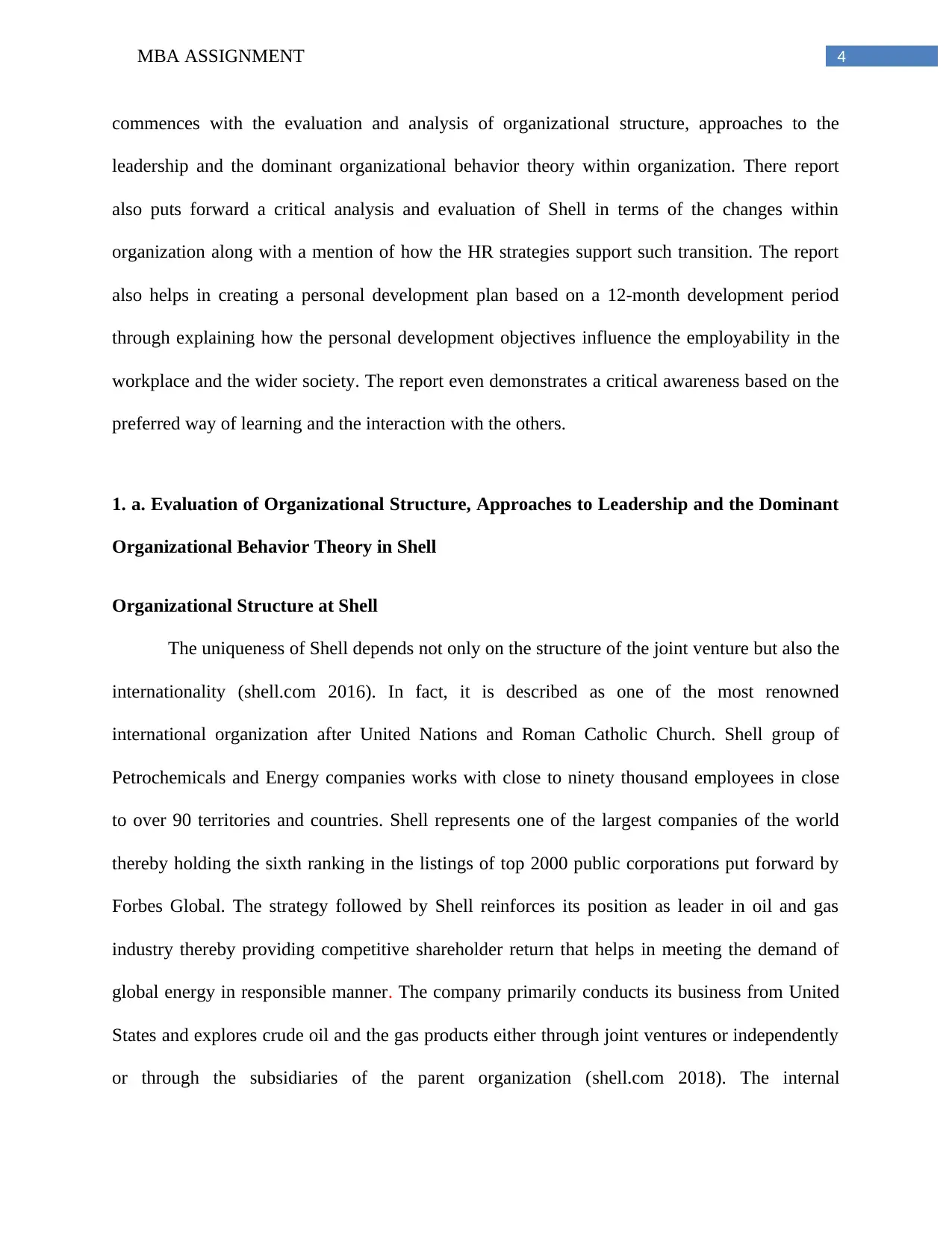
4MBA ASSIGNMENT
commences with the evaluation and analysis of organizational structure, approaches to the
leadership and the dominant organizational behavior theory within organization. There report
also puts forward a critical analysis and evaluation of Shell in terms of the changes within
organization along with a mention of how the HR strategies support such transition. The report
also helps in creating a personal development plan based on a 12-month development period
through explaining how the personal development objectives influence the employability in the
workplace and the wider society. The report even demonstrates a critical awareness based on the
preferred way of learning and the interaction with the others.
1. a. Evaluation of Organizational Structure, Approaches to Leadership and the Dominant
Organizational Behavior Theory in Shell
Organizational Structure at Shell
The uniqueness of Shell depends not only on the structure of the joint venture but also the
internationality (shell.com 2016). In fact, it is described as one of the most renowned
international organization after United Nations and Roman Catholic Church. Shell group of
Petrochemicals and Energy companies works with close to ninety thousand employees in close
to over 90 territories and countries. Shell represents one of the largest companies of the world
thereby holding the sixth ranking in the listings of top 2000 public corporations put forward by
Forbes Global. The strategy followed by Shell reinforces its position as leader in oil and gas
industry thereby providing competitive shareholder return that helps in meeting the demand of
global energy in responsible manner. The company primarily conducts its business from United
States and explores crude oil and the gas products either through joint ventures or independently
or through the subsidiaries of the parent organization (shell.com 2018). The internal
commences with the evaluation and analysis of organizational structure, approaches to the
leadership and the dominant organizational behavior theory within organization. There report
also puts forward a critical analysis and evaluation of Shell in terms of the changes within
organization along with a mention of how the HR strategies support such transition. The report
also helps in creating a personal development plan based on a 12-month development period
through explaining how the personal development objectives influence the employability in the
workplace and the wider society. The report even demonstrates a critical awareness based on the
preferred way of learning and the interaction with the others.
1. a. Evaluation of Organizational Structure, Approaches to Leadership and the Dominant
Organizational Behavior Theory in Shell
Organizational Structure at Shell
The uniqueness of Shell depends not only on the structure of the joint venture but also the
internationality (shell.com 2016). In fact, it is described as one of the most renowned
international organization after United Nations and Roman Catholic Church. Shell group of
Petrochemicals and Energy companies works with close to ninety thousand employees in close
to over 90 territories and countries. Shell represents one of the largest companies of the world
thereby holding the sixth ranking in the listings of top 2000 public corporations put forward by
Forbes Global. The strategy followed by Shell reinforces its position as leader in oil and gas
industry thereby providing competitive shareholder return that helps in meeting the demand of
global energy in responsible manner. The company primarily conducts its business from United
States and explores crude oil and the gas products either through joint ventures or independently
or through the subsidiaries of the parent organization (shell.com 2018). The internal
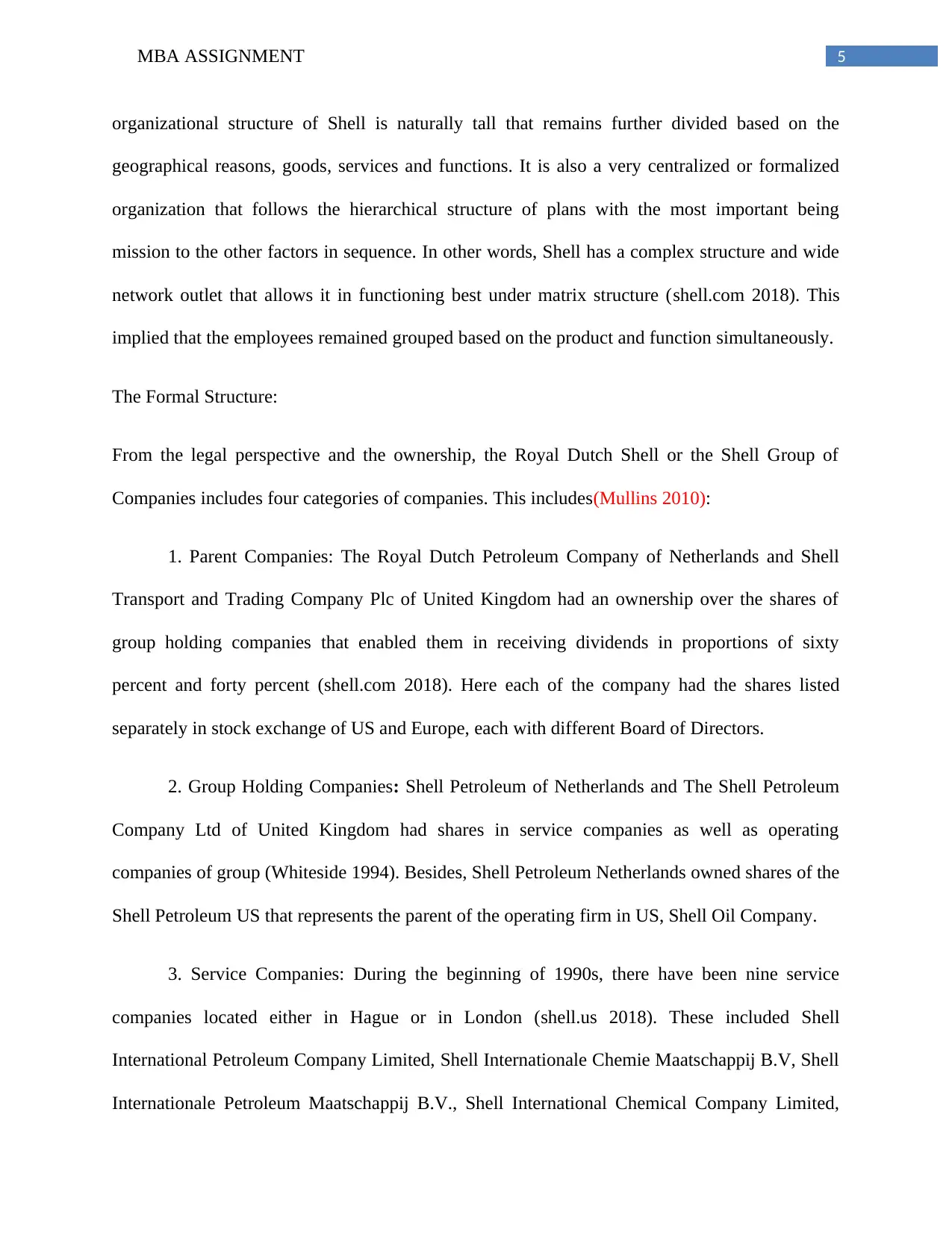
5MBA ASSIGNMENT
organizational structure of Shell is naturally tall that remains further divided based on the
geographical reasons, goods, services and functions. It is also a very centralized or formalized
organization that follows the hierarchical structure of plans with the most important being
mission to the other factors in sequence. In other words, Shell has a complex structure and wide
network outlet that allows it in functioning best under matrix structure (shell.com 2018). This
implied that the employees remained grouped based on the product and function simultaneously.
The Formal Structure:
From the legal perspective and the ownership, the Royal Dutch Shell or the Shell Group of
Companies includes four categories of companies. This includes(Mullins 2010):
1. Parent Companies: The Royal Dutch Petroleum Company of Netherlands and Shell
Transport and Trading Company Plc of United Kingdom had an ownership over the shares of
group holding companies that enabled them in receiving dividends in proportions of sixty
percent and forty percent (shell.com 2018). Here each of the company had the shares listed
separately in stock exchange of US and Europe, each with different Board of Directors.
2. Group Holding Companies: Shell Petroleum of Netherlands and The Shell Petroleum
Company Ltd of United Kingdom had shares in service companies as well as operating
companies of group (Whiteside 1994). Besides, Shell Petroleum Netherlands owned shares of the
Shell Petroleum US that represents the parent of the operating firm in US, Shell Oil Company.
3. Service Companies: During the beginning of 1990s, there have been nine service
companies located either in Hague or in London (shell.us 2018). These included Shell
International Petroleum Company Limited, Shell Internationale Chemie Maatschappij B.V, Shell
Internationale Petroleum Maatschappij B.V., Shell International Chemical Company Limited,
organizational structure of Shell is naturally tall that remains further divided based on the
geographical reasons, goods, services and functions. It is also a very centralized or formalized
organization that follows the hierarchical structure of plans with the most important being
mission to the other factors in sequence. In other words, Shell has a complex structure and wide
network outlet that allows it in functioning best under matrix structure (shell.com 2018). This
implied that the employees remained grouped based on the product and function simultaneously.
The Formal Structure:
From the legal perspective and the ownership, the Royal Dutch Shell or the Shell Group of
Companies includes four categories of companies. This includes(Mullins 2010):
1. Parent Companies: The Royal Dutch Petroleum Company of Netherlands and Shell
Transport and Trading Company Plc of United Kingdom had an ownership over the shares of
group holding companies that enabled them in receiving dividends in proportions of sixty
percent and forty percent (shell.com 2018). Here each of the company had the shares listed
separately in stock exchange of US and Europe, each with different Board of Directors.
2. Group Holding Companies: Shell Petroleum of Netherlands and The Shell Petroleum
Company Ltd of United Kingdom had shares in service companies as well as operating
companies of group (Whiteside 1994). Besides, Shell Petroleum Netherlands owned shares of the
Shell Petroleum US that represents the parent of the operating firm in US, Shell Oil Company.
3. Service Companies: During the beginning of 1990s, there have been nine service
companies located either in Hague or in London (shell.us 2018). These included Shell
International Petroleum Company Limited, Shell Internationale Chemie Maatschappij B.V, Shell
Internationale Petroleum Maatschappij B.V., Shell International Chemical Company Limited,
⊘ This is a preview!⊘
Do you want full access?
Subscribe today to unlock all pages.

Trusted by 1+ million students worldwide
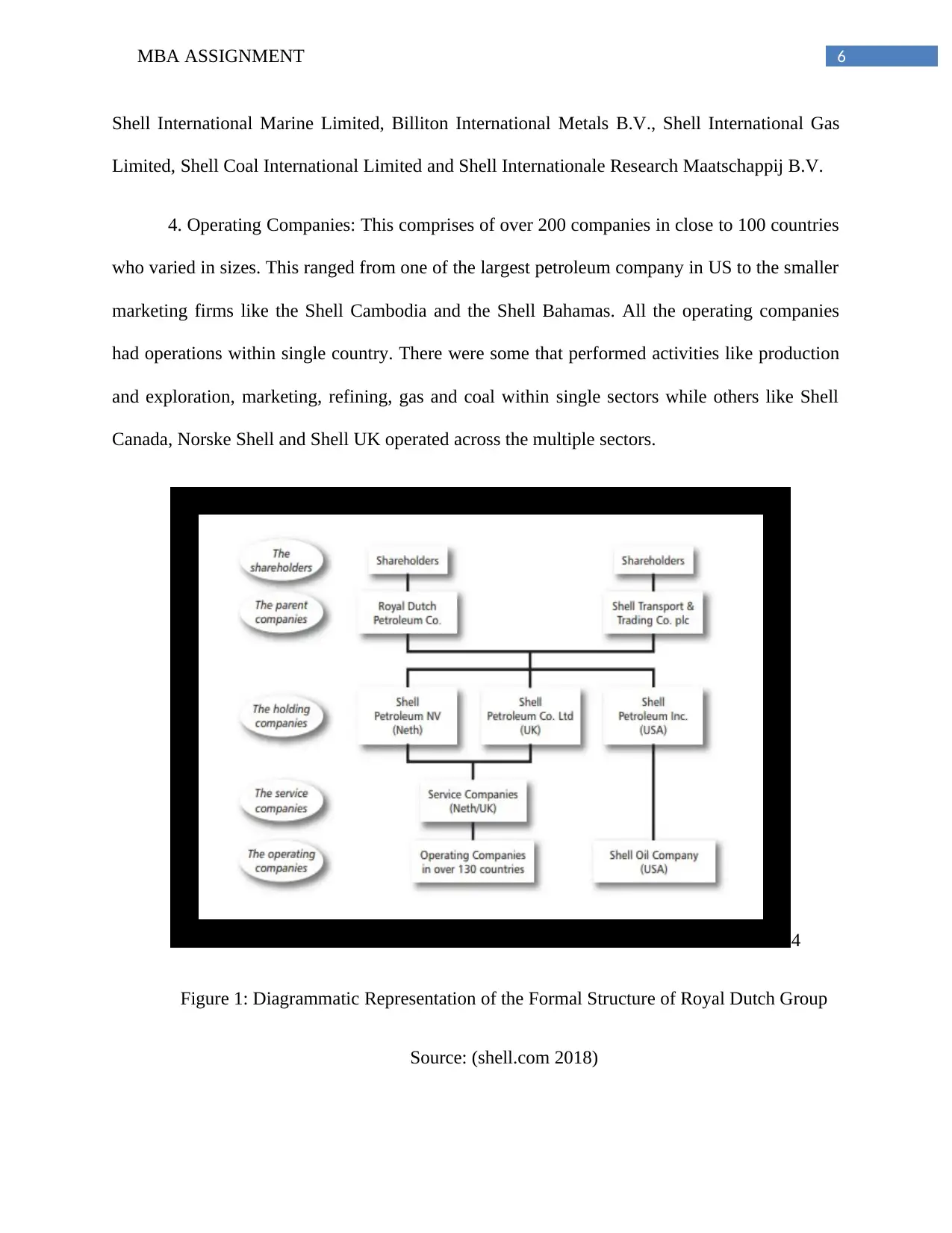
6MBA ASSIGNMENT
Shell International Marine Limited, Billiton International Metals B.V., Shell International Gas
Limited, Shell Coal International Limited and Shell Internationale Research Maatschappij B.V.
4. Operating Companies: This comprises of over 200 companies in close to 100 countries
who varied in sizes. This ranged from one of the largest petroleum company in US to the smaller
marketing firms like the Shell Cambodia and the Shell Bahamas. All the operating companies
had operations within single country. There were some that performed activities like production
and exploration, marketing, refining, gas and coal within single sectors while others like Shell
Canada, Norske Shell and Shell UK operated across the multiple sectors.
4
Figure 1: Diagrammatic Representation of the Formal Structure of Royal Dutch Group
Source: (shell.com 2018)
Shell International Marine Limited, Billiton International Metals B.V., Shell International Gas
Limited, Shell Coal International Limited and Shell Internationale Research Maatschappij B.V.
4. Operating Companies: This comprises of over 200 companies in close to 100 countries
who varied in sizes. This ranged from one of the largest petroleum company in US to the smaller
marketing firms like the Shell Cambodia and the Shell Bahamas. All the operating companies
had operations within single country. There were some that performed activities like production
and exploration, marketing, refining, gas and coal within single sectors while others like Shell
Canada, Norske Shell and Shell UK operated across the multiple sectors.
4
Figure 1: Diagrammatic Representation of the Formal Structure of Royal Dutch Group
Source: (shell.com 2018)
Paraphrase This Document
Need a fresh take? Get an instant paraphrase of this document with our AI Paraphraser
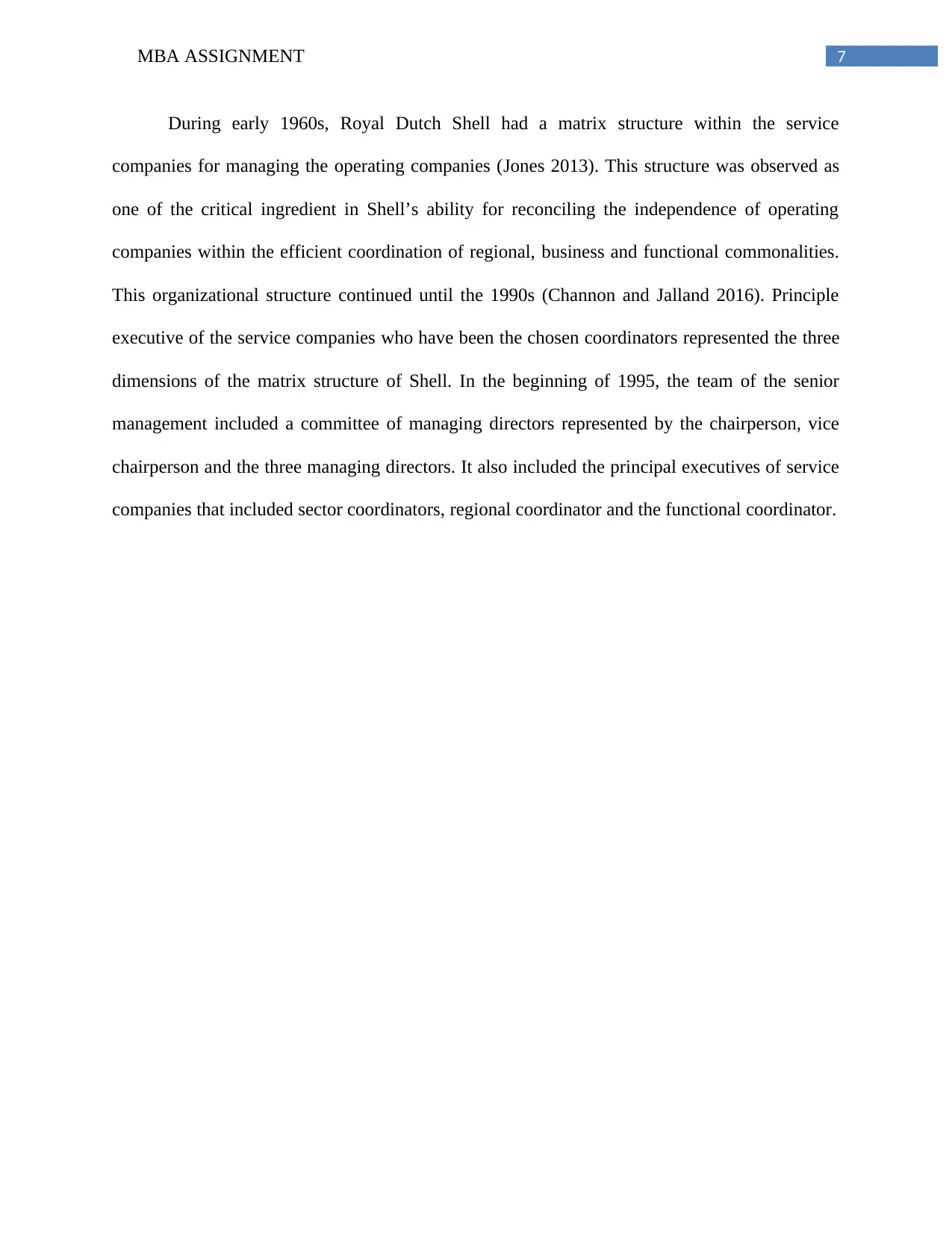
7MBA ASSIGNMENT
During early 1960s, Royal Dutch Shell had a matrix structure within the service
companies for managing the operating companies (Jones 2013). This structure was observed as
one of the critical ingredient in Shell’s ability for reconciling the independence of operating
companies within the efficient coordination of regional, business and functional commonalities.
This organizational structure continued until the 1990s (Channon and Jalland 2016). Principle
executive of the service companies who have been the chosen coordinators represented the three
dimensions of the matrix structure of Shell. In the beginning of 1995, the team of the senior
management included a committee of managing directors represented by the chairperson, vice
chairperson and the three managing directors. It also included the principal executives of service
companies that included sector coordinators, regional coordinator and the functional coordinator.
During early 1960s, Royal Dutch Shell had a matrix structure within the service
companies for managing the operating companies (Jones 2013). This structure was observed as
one of the critical ingredient in Shell’s ability for reconciling the independence of operating
companies within the efficient coordination of regional, business and functional commonalities.
This organizational structure continued until the 1990s (Channon and Jalland 2016). Principle
executive of the service companies who have been the chosen coordinators represented the three
dimensions of the matrix structure of Shell. In the beginning of 1995, the team of the senior
management included a committee of managing directors represented by the chairperson, vice
chairperson and the three managing directors. It also included the principal executives of service
companies that included sector coordinators, regional coordinator and the functional coordinator.
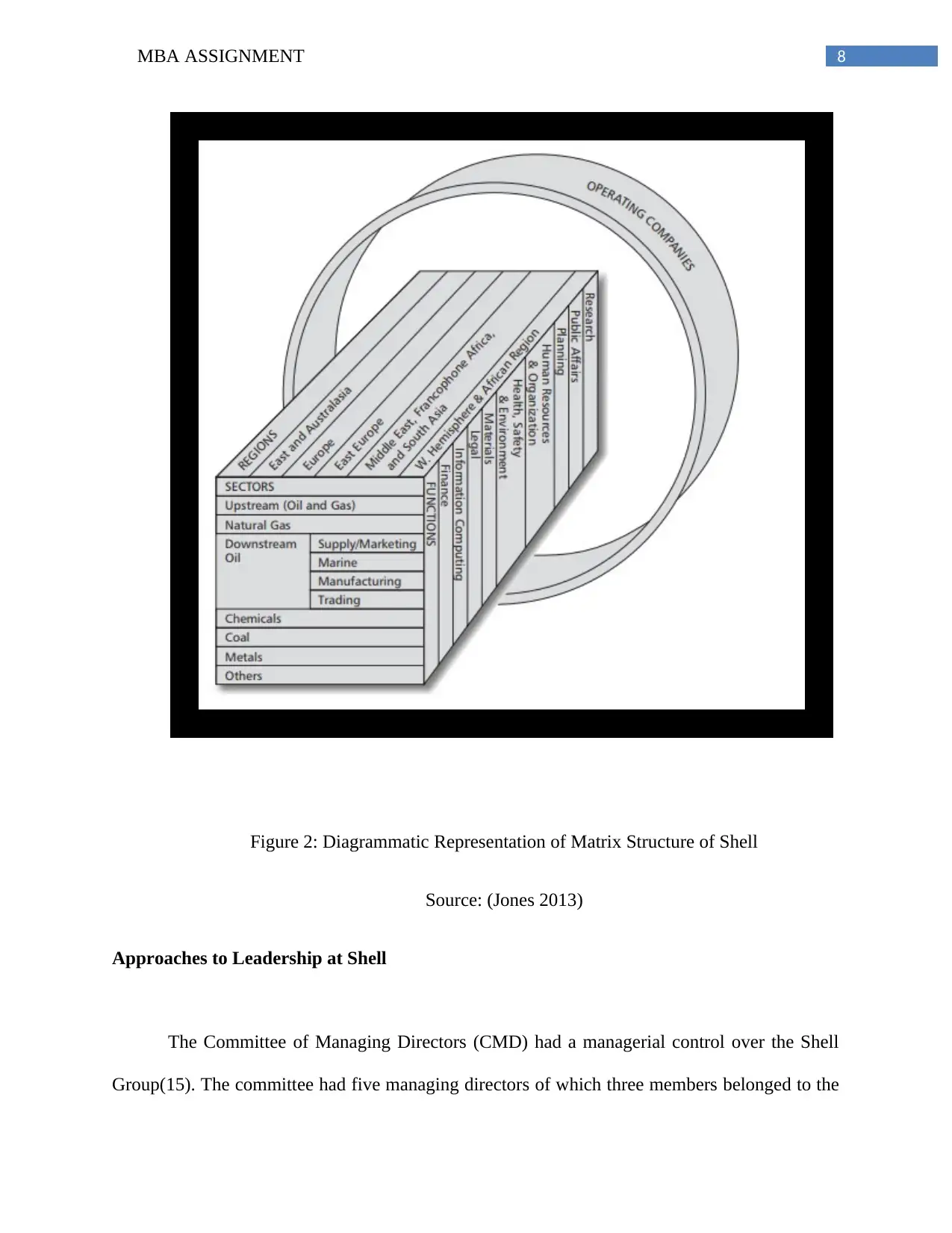
8MBA ASSIGNMENT
Figure 2: Diagrammatic Representation of Matrix Structure of Shell
Source: (Jones 2013)
Approaches to Leadership at Shell
The Committee of Managing Directors (CMD) had a managerial control over the Shell
Group(15). The committee had five managing directors of which three members belonged to the
Figure 2: Diagrammatic Representation of Matrix Structure of Shell
Source: (Jones 2013)
Approaches to Leadership at Shell
The Committee of Managing Directors (CMD) had a managerial control over the Shell
Group(15). The committee had five managing directors of which three members belonged to the
⊘ This is a preview!⊘
Do you want full access?
Subscribe today to unlock all pages.

Trusted by 1+ million students worldwide
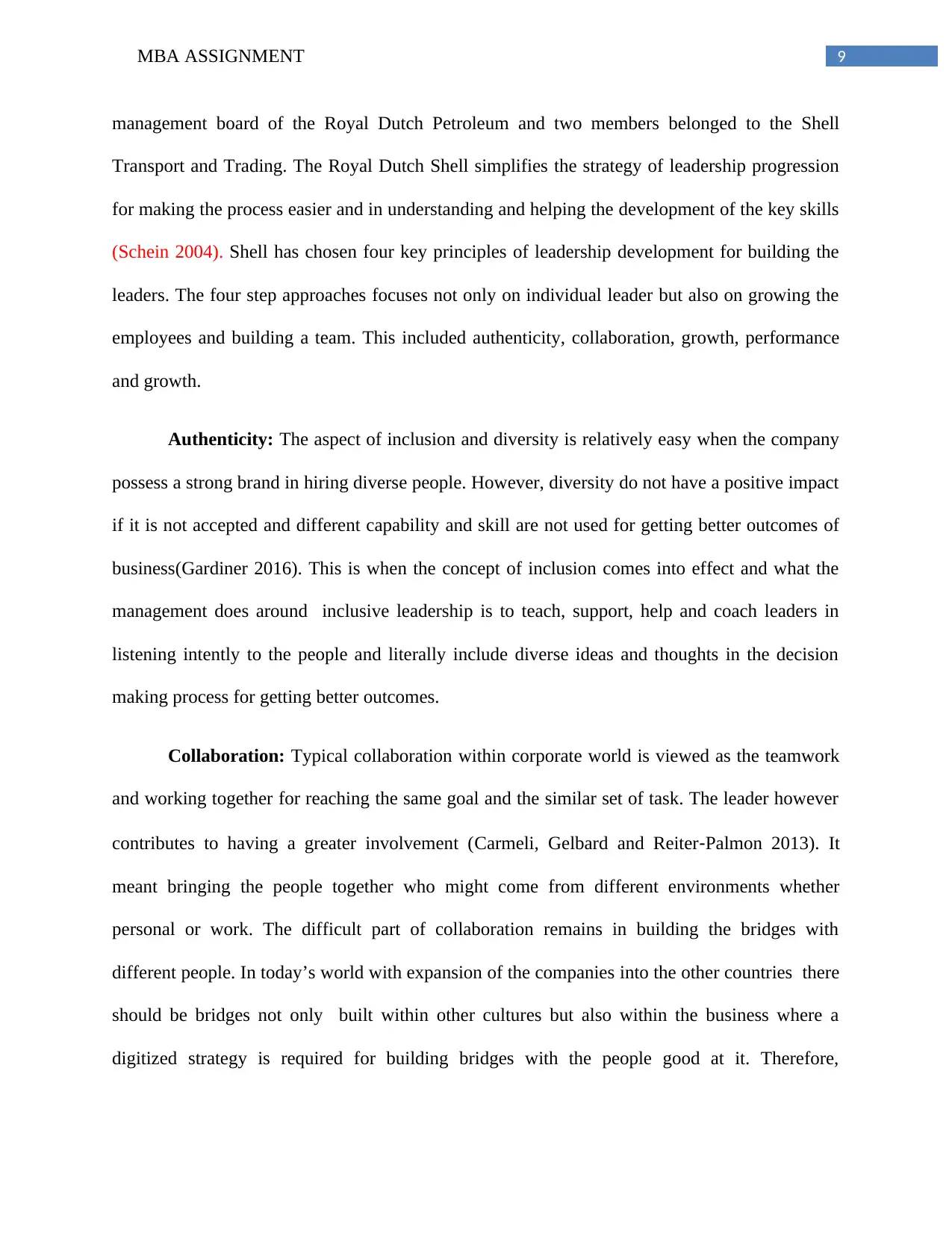
9MBA ASSIGNMENT
management board of the Royal Dutch Petroleum and two members belonged to the Shell
Transport and Trading. The Royal Dutch Shell simplifies the strategy of leadership progression
for making the process easier and in understanding and helping the development of the key skills
(Schein 2004). Shell has chosen four key principles of leadership development for building the
leaders. The four step approaches focuses not only on individual leader but also on growing the
employees and building a team. This included authenticity, collaboration, growth, performance
and growth.
Authenticity: The aspect of inclusion and diversity is relatively easy when the company
possess a strong brand in hiring diverse people. However, diversity do not have a positive impact
if it is not accepted and different capability and skill are not used for getting better outcomes of
business(Gardiner 2016). This is when the concept of inclusion comes into effect and what the
management does around inclusive leadership is to teach, support, help and coach leaders in
listening intently to the people and literally include diverse ideas and thoughts in the decision
making process for getting better outcomes.
Collaboration: Typical collaboration within corporate world is viewed as the teamwork
and working together for reaching the same goal and the similar set of task. The leader however
contributes to having a greater involvement (Carmeli, Gelbard and Reiter‐Palmon 2013). It
meant bringing the people together who might come from different environments whether
personal or work. The difficult part of collaboration remains in building the bridges with
different people. In today’s world with expansion of the companies into the other countries there
should be bridges not only built within other cultures but also within the business where a
digitized strategy is required for building bridges with the people good at it. Therefore,
management board of the Royal Dutch Petroleum and two members belonged to the Shell
Transport and Trading. The Royal Dutch Shell simplifies the strategy of leadership progression
for making the process easier and in understanding and helping the development of the key skills
(Schein 2004). Shell has chosen four key principles of leadership development for building the
leaders. The four step approaches focuses not only on individual leader but also on growing the
employees and building a team. This included authenticity, collaboration, growth, performance
and growth.
Authenticity: The aspect of inclusion and diversity is relatively easy when the company
possess a strong brand in hiring diverse people. However, diversity do not have a positive impact
if it is not accepted and different capability and skill are not used for getting better outcomes of
business(Gardiner 2016). This is when the concept of inclusion comes into effect and what the
management does around inclusive leadership is to teach, support, help and coach leaders in
listening intently to the people and literally include diverse ideas and thoughts in the decision
making process for getting better outcomes.
Collaboration: Typical collaboration within corporate world is viewed as the teamwork
and working together for reaching the same goal and the similar set of task. The leader however
contributes to having a greater involvement (Carmeli, Gelbard and Reiter‐Palmon 2013). It
meant bringing the people together who might come from different environments whether
personal or work. The difficult part of collaboration remains in building the bridges with
different people. In today’s world with expansion of the companies into the other countries there
should be bridges not only built within other cultures but also within the business where a
digitized strategy is required for building bridges with the people good at it. Therefore,
Paraphrase This Document
Need a fresh take? Get an instant paraphrase of this document with our AI Paraphraser
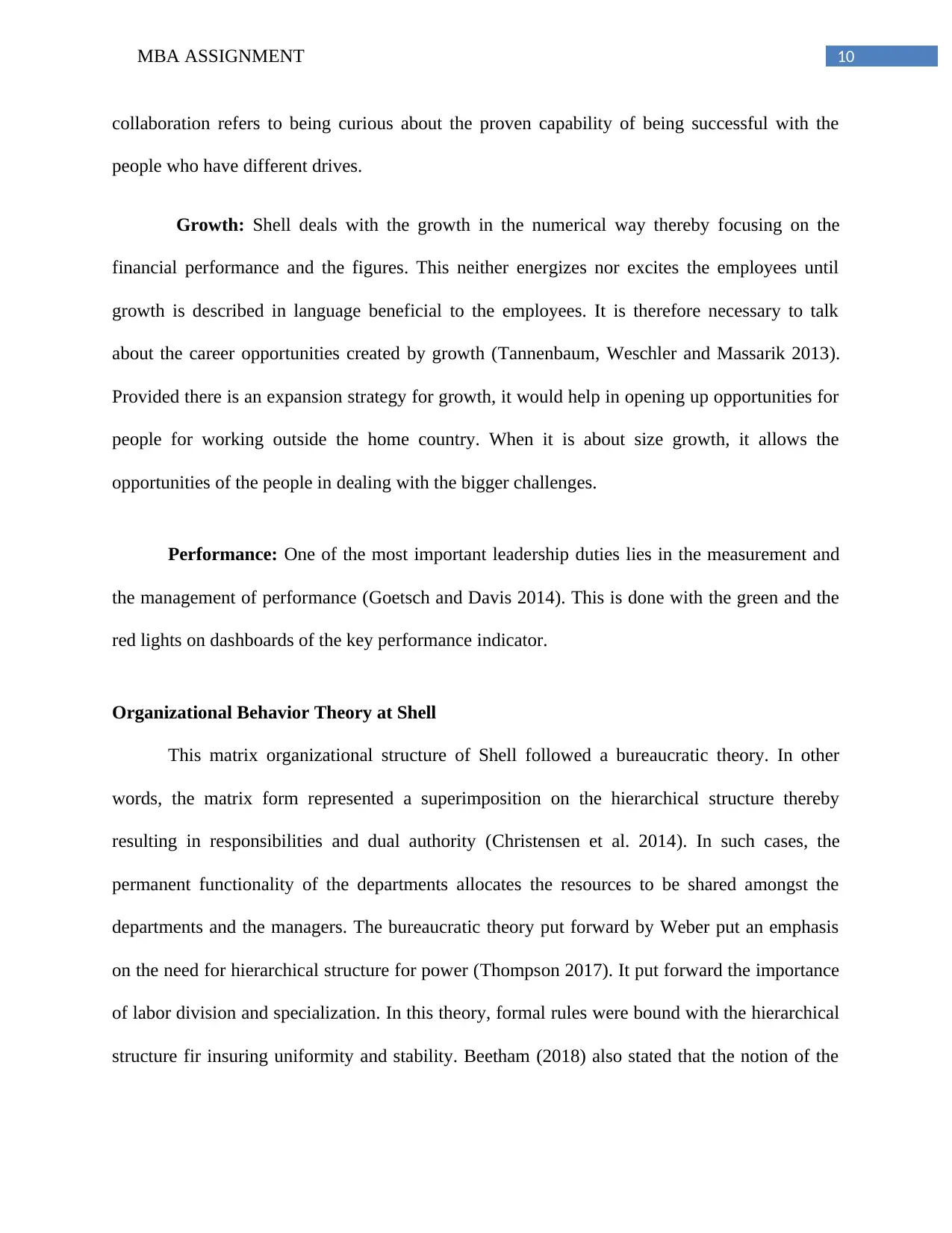
10MBA ASSIGNMENT
collaboration refers to being curious about the proven capability of being successful with the
people who have different drives.
Growth: Shell deals with the growth in the numerical way thereby focusing on the
financial performance and the figures. This neither energizes nor excites the employees until
growth is described in language beneficial to the employees. It is therefore necessary to talk
about the career opportunities created by growth (Tannenbaum, Weschler and Massarik 2013).
Provided there is an expansion strategy for growth, it would help in opening up opportunities for
people for working outside the home country. When it is about size growth, it allows the
opportunities of the people in dealing with the bigger challenges.
Performance: One of the most important leadership duties lies in the measurement and
the management of performance (Goetsch and Davis 2014). This is done with the green and the
red lights on dashboards of the key performance indicator.
Organizational Behavior Theory at Shell
This matrix organizational structure of Shell followed a bureaucratic theory. In other
words, the matrix form represented a superimposition on the hierarchical structure thereby
resulting in responsibilities and dual authority (Christensen et al. 2014). In such cases, the
permanent functionality of the departments allocates the resources to be shared amongst the
departments and the managers. The bureaucratic theory put forward by Weber put an emphasis
on the need for hierarchical structure for power (Thompson 2017). It put forward the importance
of labor division and specialization. In this theory, formal rules were bound with the hierarchical
structure fir insuring uniformity and stability. Beetham (2018) also stated that the notion of the
collaboration refers to being curious about the proven capability of being successful with the
people who have different drives.
Growth: Shell deals with the growth in the numerical way thereby focusing on the
financial performance and the figures. This neither energizes nor excites the employees until
growth is described in language beneficial to the employees. It is therefore necessary to talk
about the career opportunities created by growth (Tannenbaum, Weschler and Massarik 2013).
Provided there is an expansion strategy for growth, it would help in opening up opportunities for
people for working outside the home country. When it is about size growth, it allows the
opportunities of the people in dealing with the bigger challenges.
Performance: One of the most important leadership duties lies in the measurement and
the management of performance (Goetsch and Davis 2014). This is done with the green and the
red lights on dashboards of the key performance indicator.
Organizational Behavior Theory at Shell
This matrix organizational structure of Shell followed a bureaucratic theory. In other
words, the matrix form represented a superimposition on the hierarchical structure thereby
resulting in responsibilities and dual authority (Christensen et al. 2014). In such cases, the
permanent functionality of the departments allocates the resources to be shared amongst the
departments and the managers. The bureaucratic theory put forward by Weber put an emphasis
on the need for hierarchical structure for power (Thompson 2017). It put forward the importance
of labor division and specialization. In this theory, formal rules were bound with the hierarchical
structure fir insuring uniformity and stability. Beetham (2018) also stated that the notion of the
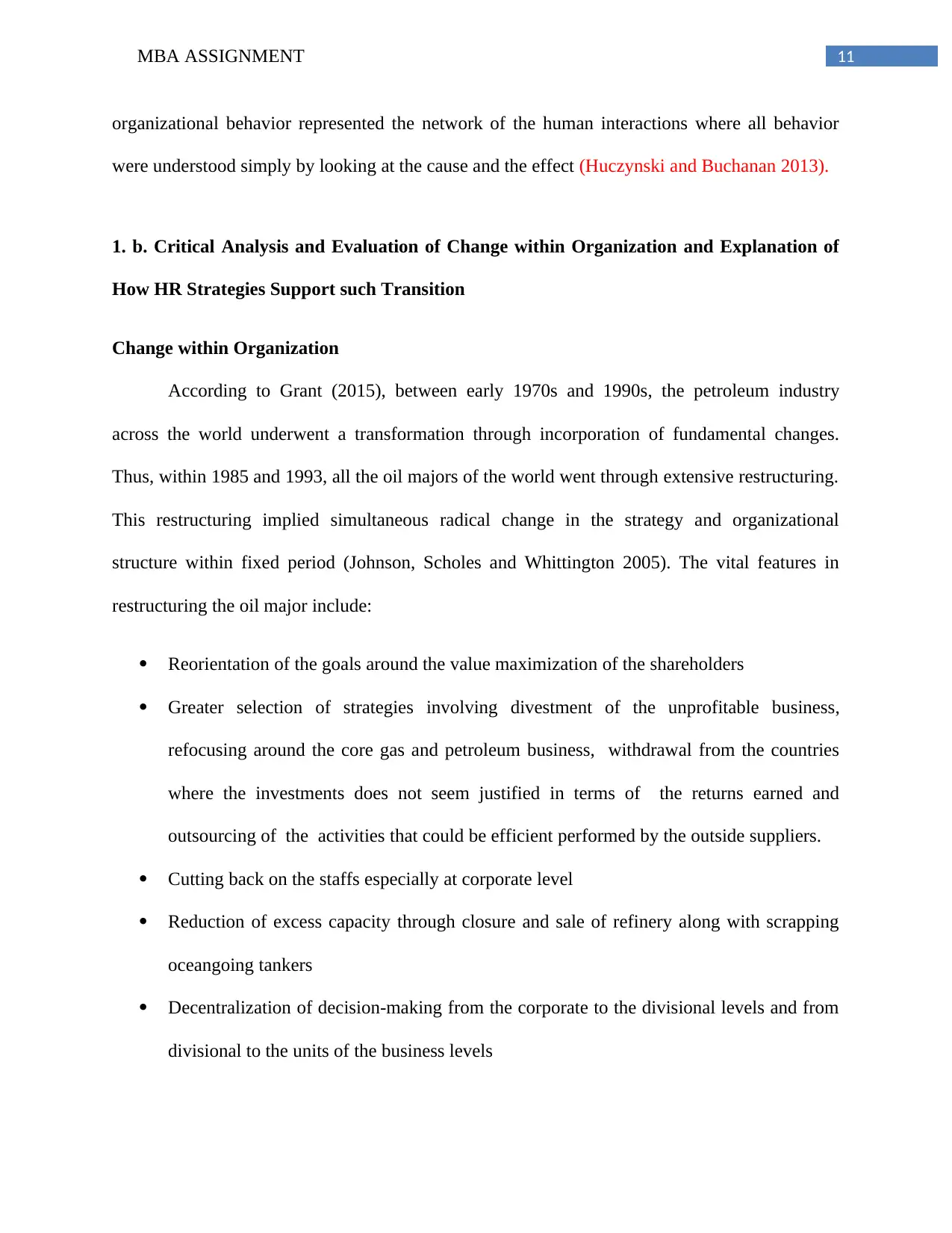
11MBA ASSIGNMENT
organizational behavior represented the network of the human interactions where all behavior
were understood simply by looking at the cause and the effect (Huczynski and Buchanan 2013).
1. b. Critical Analysis and Evaluation of Change within Organization and Explanation of
How HR Strategies Support such Transition
Change within Organization
According to Grant (2015), between early 1970s and 1990s, the petroleum industry
across the world underwent a transformation through incorporation of fundamental changes.
Thus, within 1985 and 1993, all the oil majors of the world went through extensive restructuring.
This restructuring implied simultaneous radical change in the strategy and organizational
structure within fixed period (Johnson, Scholes and Whittington 2005). The vital features in
restructuring the oil major include:
Reorientation of the goals around the value maximization of the shareholders
Greater selection of strategies involving divestment of the unprofitable business,
refocusing around the core gas and petroleum business, withdrawal from the countries
where the investments does not seem justified in terms of the returns earned and
outsourcing of the activities that could be efficient performed by the outside suppliers.
Cutting back on the staffs especially at corporate level
Reduction of excess capacity through closure and sale of refinery along with scrapping
oceangoing tankers
Decentralization of decision-making from the corporate to the divisional levels and from
divisional to the units of the business levels
organizational behavior represented the network of the human interactions where all behavior
were understood simply by looking at the cause and the effect (Huczynski and Buchanan 2013).
1. b. Critical Analysis and Evaluation of Change within Organization and Explanation of
How HR Strategies Support such Transition
Change within Organization
According to Grant (2015), between early 1970s and 1990s, the petroleum industry
across the world underwent a transformation through incorporation of fundamental changes.
Thus, within 1985 and 1993, all the oil majors of the world went through extensive restructuring.
This restructuring implied simultaneous radical change in the strategy and organizational
structure within fixed period (Johnson, Scholes and Whittington 2005). The vital features in
restructuring the oil major include:
Reorientation of the goals around the value maximization of the shareholders
Greater selection of strategies involving divestment of the unprofitable business,
refocusing around the core gas and petroleum business, withdrawal from the countries
where the investments does not seem justified in terms of the returns earned and
outsourcing of the activities that could be efficient performed by the outside suppliers.
Cutting back on the staffs especially at corporate level
Reduction of excess capacity through closure and sale of refinery along with scrapping
oceangoing tankers
Decentralization of decision-making from the corporate to the divisional levels and from
divisional to the units of the business levels
⊘ This is a preview!⊘
Do you want full access?
Subscribe today to unlock all pages.

Trusted by 1+ million students worldwide
1 out of 33
Related Documents
Your All-in-One AI-Powered Toolkit for Academic Success.
+13062052269
info@desklib.com
Available 24*7 on WhatsApp / Email
![[object Object]](/_next/static/media/star-bottom.7253800d.svg)
Unlock your academic potential
Copyright © 2020–2025 A2Z Services. All Rights Reserved. Developed and managed by ZUCOL.





